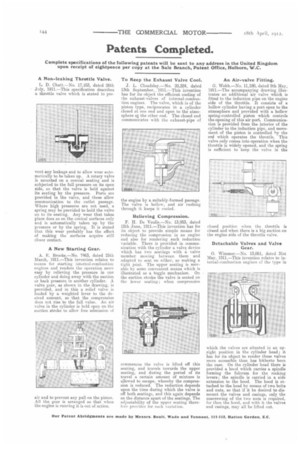Patents Completed.
Page 22

If you've noticed an error in this article please click here to report it so we can fix it.
Complete specifications of the following patents will be sent to any address in the United Kingdom upon receipt of eightpence per copy at the Sale Branch, Patent Office, Holborn, W.C.
A Non-leaking Throttle Valve.
Te D. Chatt.—No. 17,103, dated 26th July, 1911.—This specification describes a throttle valve which is stated to pre
vent any leakage and to allow wear automatically to be taken up. A rotary valve is mounted on a conical seating and is subjected to the full pressure on its open side, so that the valve is held against. its Beating by the pressure. Ports are provided in the valve, and these allow communication to the outlet passage. Where high pressures are not used, a spring may be provided to hold the valve on to its seating. Any wear that takes place does so on the conical surfaces only and is automatically taken up by the pressure or by the spring_ It is stated that this wear probably has the effect of making the surfaces acquire still closer contact.
A New Starting Gear.
A. .E, Brooks.—No. 7463, dated 25th March, 1911.—This invention relates to means for starting internal-combustion engines and renders the operation more easy by relieving the pressure in one cylinder and doing away with the suction or back pressure in another cylinder. A valve gear, as shown in the drawing, is provided, and in this a relief valve is loaded by a weighted lever to the desired amount, so that the compression does not rise to the full value. An air valve in the cylinder is held open on the suction stroke to allow free admission of air and to prevent any pull on the piston. All the gear is arranged so that when the engine is running it is out of action.
To Keep the Exhaust Valve Cool.
J. L. Cloudsley.—No. 20,324, dated 13th September, , 1911.—This invention has for its object the efficient cooling of the exhaust-valves of internal-combustion. engines. The valve, which is of the piston type, reciprocates in a cylinder closed at one end and open to the atmosphere al the other end. The closed end communicates with the exhaust-pipe of the engine by a suitably-formed passage. The valve is hollow, and air rushing through it keeps it cooled.
Relieving Compression.
F. H. De Veulle.—No. 13,953, dated 12th June, 1911.—This invention has for its object to provide simple means for reducing the compression in an engine and also for rendering such reduction variable. There is provided in communication with the cylinder a valve device which has two seatings with a valve member moving between them and adapted to seat on either, so making a tight joint. The upper seating is movable by some convenient means which is illustrated as a toggle mechanism. On the suction stroke the valve is seated on the lower seating ; when compression
commences the valve is lifted off this seating, and travels towards the upper seating, and during the period of its travel a certain amount of mixture is allowed to escape, whereby the compression is reduced. The reduction depends upon the time during which the valve is off both .seatings, and this again depends on the distance apart of the seatings. The adjustability of the upper seating therefore provides for such variation.
An Air-valve Fitting.
G. Webb.—No. 11,180, dated 9th May, 1911.—The accompanying drawing illustrates an additional air valve which is fitted to the induction pipe on the engine side of the throttle. It, consists of a hollow cylinder having a port open to the atmosphere and provided with a hollow spring-controlled piston which controls the opening of this air port. Communication is provided from the interior of the cylinder to the induction pipe, and movement of the piston is controlled 1iy the rod which operates the throttle. This valve only comes into operation when the throttle is widely opened, and the spring is sufficient to keep the valve in the
closed position when the throttle is closed and when there is a big suction on the engine side of the throttle valve.
Detachable Valves and Valve Gear.
0. Wimmer.—No. 13,061, dated 31st May, 1911.—This invention relates to in, ternal-corubustion engines of the type in which the valves are situated in an upright position in the cylinder head; it has for its object to render these valves more accessible than has hitherto been the case. On the cylinder head there is provided a hood which carries a spindle forming the fulcrum for the rocking levers; the spindle is carried in a side extension to the hood. The hood is attached to the head by means of two bolts and nuts, so that if it be desired to dismount the valves and casings, only the unscrewing of the two nuts is required, for then the hood, and with it the valves and casings, may all be lifted out.






















